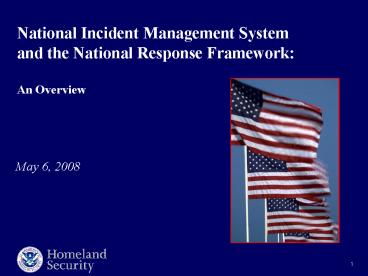National Incident Management System and the National Response Framework: An Overview
1 / 12
Title:
National Incident Management System and the National Response Framework: An Overview
Description:
FEMA intends to make the NRF nimble, accessible, and user-friendly by ... FEMA's Emergency Management Institute's Independent Study office will notify ... –
Number of Views:315
Avg rating:3.0/5.0
Title: National Incident Management System and the National Response Framework: An Overview
1
National Incident Management System and the
National Response FrameworkAn Overview
May 6, 2008
1
2
Homeland Security Presidential Directive 5
- National Incident Management System (NIMS)
- A consistent nationwide approach for all levels
of government to work effectively and efficiently
together to prepare for and respond to domestic
incidents - Core set of concepts, principles and terminology
for incident command and multi-agency
coordination
3
NIMS Key Concepts
- Framework for interoperability and compatibility
- Flexibility
- Consistent, flexible, and adjustable national
framework - Applicable regardless of incident cause, size,
location, or complexity. - Standardization
- Standard organizational structures
- Key to interoperability
- Ongoing support Incident Management Systems
Integration
4
NIMS Components
- Preparedness
- Communications and Information
- Management
- Resource Management
- Command and Management
- Incident Command System
- Multi-agency Coordination Systems
- Public Information
- Ongoing Management and Maintenance
5
National Integration CenterIncident Management
Systems
- NIMS Website Information
- http//www.fema.gov/emergency/nims
- Contact the NIC
- Email FEMA-NIMS_at_dhs.gov
- Phone 202-646-3534
6
National Response Framework
- Various Katrina AARs and the law (PKEMRA)
mandated a revision to the National Response
Plan, result the National Response Framework
which became effective March 22, 2008 - The review process took 18 months, and included
public review during an NRF comment period
(closed November 10, 2007) gathered nearly 5,500
comments from governmental, private sector, and
nonprofit partners - The online NRF Resource Center (www.fema.gov/nrf)
will allow for additional revisions that reflect
real-world events and lessons learned
FEMA intends to make the NRF nimble, accessible,
and user-friendly by facilitating updates and
continuing to collaborate with key partners
7
How the Framework is Organized
Doctrine, organization, roles and
responsibilities, response actions and planning
requirements that guide national response
Mechanisms to group and provide Federal resources
and capabilities to support State and local
responders
Emergency Support Function Annexes
Support Annexes
Essential supporting aspects of the Federal
response common to all incidents
Incident Annexes
Incident-specific applications of the Framework
Partner Guides
Next level of detail in response actions tailored
to the actionable entity
7
www.fema.gov/nrf
8
Emergency Support Functions / Annexes
- ESF 1 - Transportation
- ESF 2 - Communications
- ESF 3 - Public Works and Engineering
- ESF 4 - Firefighting
- ESF 5 - Emergency Management
- ESF 6 - Mass Care, Emergency Assistance,
Housing and Human Services - ESF 7 - Logistics Management and Resource
Support - ESF 8 - Public Health and Medical Services
- ESF 9 - Search and Rescue
- ESF 10 - Oil and Hazardous Materials Response
- ESF 11 - Agriculture and Natural Resources
- ESF 12 - Energy
- ESF 13 - Public Safety and Security
- ESF 14 - Long-Term Community Recovery
- ESF 15 - External Affairs
8
9
Support Annexes
Incident Annexes
- Critical Infrastructure and Key Resources
- Financial Management
- International Coordination
- Private Sector Coordination
- Public Affairs
- Tribal Relations
- Volunteer and Donations Management
- Worker Safety and Health
- Biological Incident
- Catastrophic Incident
- Cyber Incident
- Food and Agriculture Incident
- Mass Evacuation Incident
- Nuclear/Radiological Incident
- Terrorism Incident Law Enforcement and
Investigation
New annexes
9
10
The Framework Building New Capability
- Preparedness Cyclea system that builds the right
capabilities - Introduces National Planning System
- Defines response organization
- Requires training
- Advocates interoperability and typing of
equipment - Emphasizes exercising with broad-based
participation - Describes process for continuous evaluation and
improvement - Aligning Risk-Based Planning
- National Planning Scenarios
- Hazard Identification and Risk Analysis
Capability Building
10
11
IS-800B, An Introduction to the NRF
- Course Completion This course is available at
http//www.training.fema.gov/EMIWeb/IS/IS800b.asp.
FEMAs Emergency Management Institutes
Independent Study office will notify individuals
via email of their successful completion of the
course. - Questions Individuals may contact the
Independent Study office via email
Independent.Study_at_dhs.gov or contact the call
center at 301-447-1200 or toll free at
1-800-238-3358, extension 1200. Independent
Study Program office hours are 730a.m.-730p.m.
(EDT). - All NRF documents are available through the NRF
Resource Center at www.fema.gov/nrf
11
12
(No Transcript)
























![National Response Plan Overview [date] [location] [presenter]](https://s3.amazonaws.com/images.powershow.com/4218293.th0.jpg?_=20130928108)






